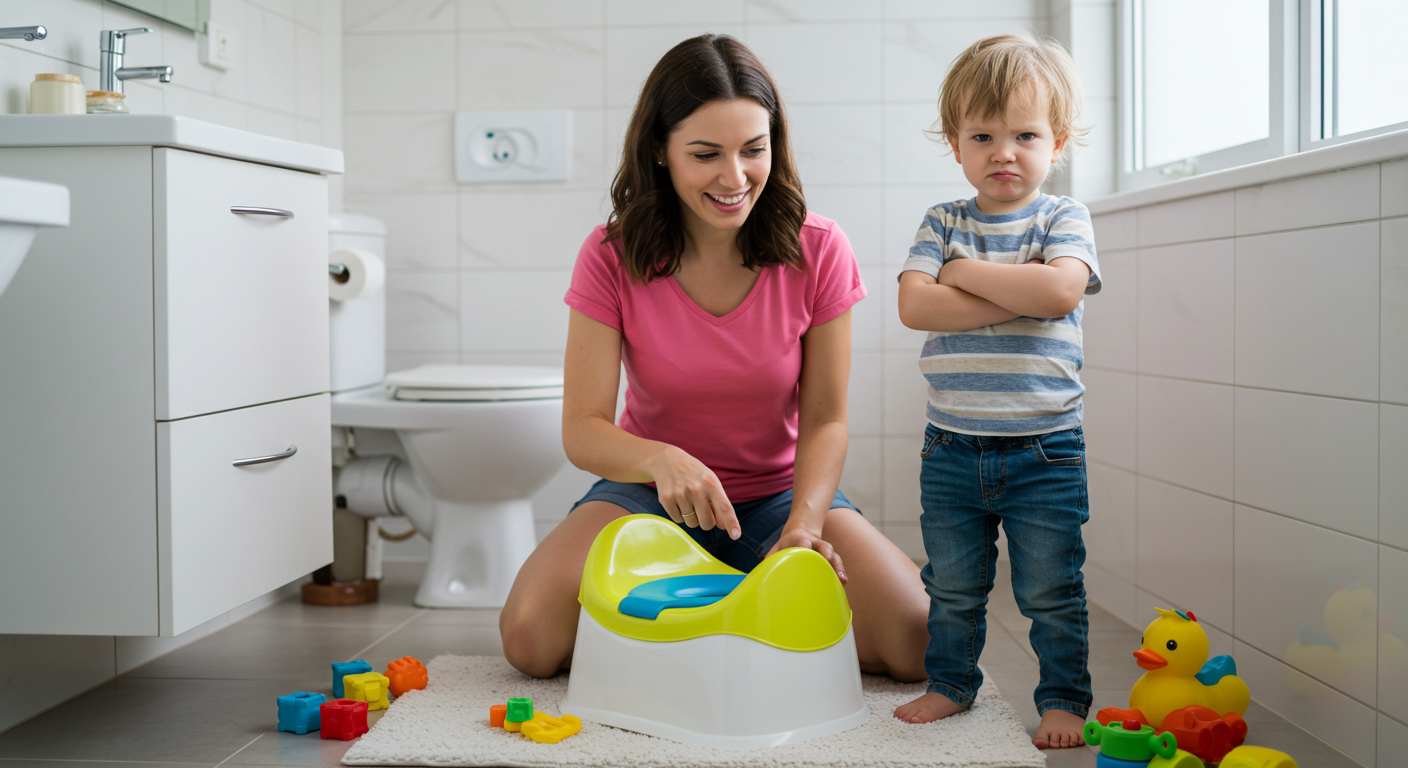Potty Training Regression:
How to Handle Setbacks, Accidents, and Challenges

If your child has already been potty trained but suddenly starts having accidents again, you’re not alone. Potty training regression is a common and frustrating phase many parents face. The good news is that with understanding, consistency, and some practical tips, you can help your child get back on track quickly. This article explores causes and offers proven tips on how to manage and overcome it.
What Is Potty Training Regression?
Potty training regression refers to a child who was previously potty trained starting to have accidents again, either with urination, bowel movements, or both. This can happen weeks, months, or even a year after your child seemed fully trained. Regression can be mild and short-lived or more persistent, depending on the cause and the child.
It’s important to know that regression is not a failure on your part as a parent, nor does it mean your child is “going backward” developmentally in a serious way. In fact, over 50% of parents report experiencing some type of potty training regression with their child after they were fully trained.
Common Causes of Potty Training Regression
There are many reasons why a child may suddenly start having accidents again. Understanding the cause of potty training regression can help guide how you respond. Here are some of the most common triggers:
-
The arrival of a new sibling
Major life changes like welcoming a baby can cause emotional upheaval in toddlers. Your child may regress as a way of seeking attention or expressing anxiety. -
Changes in routine or environment
Moving to a new home, starting daycare, switching caregivers, or travel can all disrupt routines and trigger regression. -
Illness or physical discomfort
Issues like constipation, urinary tract infections, or a cold can make using the potty uncomfortable or less of a priority. -
Parental separation or divorce
Emotional stress in the family often shows up through changes in eating, sleeping, or potty habits. -
Inconsistent training methods
Using disposable training pants part-time or failing to maintain potty-time routines can confuse children and reduce their motivation.
Tips for Dealing with Potty Training Regression
The key to managing potty training regression is patience, consistency, and positive reinforcement. Below are some actionable tips on how to support your child through this phase:
1. Identify the Cause
Start by observing your child’s environment and recent life events. Is there a clear trigger such as a new baby, recent illness, or a stressful family situation? Understanding the reason behind the regression can help you decide if your child simply needs more support or if changes to the routine are necessary.
2. Reinforce Potty Habits with Routine
Reintroduce elements from your original potty training routine. This could mean:
- Prompting your child to use the potty every 30–45 minutes.
- Practicing dry runs to the toilet after accidents.
- Using a free printable potty chart to track successes and offer small rewards.
Remind your child calmly, and avoid scolding for accidents. Gentle reminders and encouragement can go a long way.
3. Evaluate Readiness
In some cases, potty training regression happens because the child was not truly ready when potty training started. If regression appears shortly after training was completed and your child struggles to stay dry despite consistent effort, it may be helpful to revisit the checklist for potty training readiness:
- Can they stay dry for two hours?
- Do they show interest in using the potty?
- Can they communicate the need to go?
If your child isn’t meeting these readiness markers, it may be better to pause and try again in a few weeks. When restarting, try using potty training videos like the ones below, simply watching them daily for a week or two to help acclimate them to the concept then going back step by step with the potty training in three days method..
How to Handle Purposeful Potty Training Regression
In some situations, accidents aren’t due to stress or lack of readiness—they’re done intentionally to avoid a task or activity. This type of behavior often requires a slightly different approach.
We experienced this with our son during his first year of being potty trained. He began having accidents during nap time and time-outs at preschool, clearly using it as a way to avoid unpleasant situations.What Worked for Us:
- Follow through with the original activity despite the accident. If the accident was used to avoid nap time, he still had to finish the rest period.
- Involve the child in cleanup. This helps them understand that accidents have consequences without making them feel ashamed.
- Switch to cloth training pants with vinyl covers instead of “big kid” underwear. We calmly explained that pee and poop go in the potty, and until he remembered how to do that, he would wear the more bulky, less comfortable training pants.
This method was not punitive but clear and consistent. It avoided embarrassment while reducing the mess and making it less likely he would repeat the behavior for attention or avoidance.
Stay Positive and Consistent
The most important tip for handling potty training regression is to remain calm and consistent. Yelling, punishment, or shame will only make your child feel anxious, which can lead to even more accidents. Instead, use praise, rewards, and consistency to reinforce the desired behavior.
Here’s a quick checklist of helpful tools:
- Free printable potty charts for stickers
- Timer or smartphone reminders
- Positive language like “I’m proud of you for trying!”
- Celebratory routines like songs, dances, or special stickers
- A big kid toilet training certificate to recognize major milestones
If you haven't already, be sure to check out my ebooks, now on Amazon!

